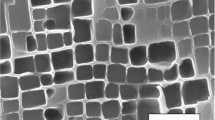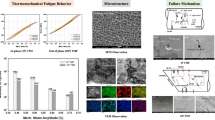Abstract
The effects of temperature on low cycle fatigue (LCF) behavior of Superni 263 superalloy in the solution annealed plus aged state were examined between 298 and 1023 K. The initial microstructure consisted of intragranular spherical γʹ (22 nm), intergranular M23C6 carbides and a few un-dissolved primary MC particles. Strain-controlled LCF tests were performed at a strain rate of 10−3 s−1. Correlations between the initial microstructure, macroscopic cyclic deformation, fatigue life, crack initiation and propagation modes, evolving deformation substructure and phase changes have been attempted. Cyclic stress response displayed a marked variation in its temperature dependence. In general, the alloy exhibited initial hardening followed by very slight softening up to 473 K, continuous hardening to a maximum stress in between 573 and 873 K, and initial hardening succeeded by rapid softening at and above 923 K. Dynamic Strain Ageing (DSA) was noticed during 573–923 K. In the DSA domain, the alloy exhibited pronounced cyclic hardening at 673 K, displayed planar slip, stacking faults, high dislocation density and shearing of γʹ. The macroscopic features revealed serrated flow in the plastic deformation portions of stress–strain hysteresis loops and inverse temperature dependence of maximum stress and inelastic strain generated at half-life. Fresh precipitation of γʹ occurred at 973 K and 1023 K during LCF testing while prior existing γʹ coarsened marginally above 923 K. The operating deformation mechanisms of γʹ were identified and correlated with microscopic and macroscopic aspects. LCF life displayed a maximum at ~ 473 K and the reduction in life above 473 K was attributed to the deleterious effects of DSA and oxidation.














Similar content being viewed by others
References
Antonovich S, Rosa D, Pineau A (1981) Low cycle fatigue of René 77 at elevated temperatures. Mater Sci Eng 47:47–57
Beukel A, Kocks UF (1982) The strain dependence of static and dynamic strain-aging. Acta Metall 30:1027–1034
Bhanu Sankara Rao K (1989) Influence of metallurgical variables on low cycle fatigue behavior of type 304 stainless steel-Grain size, cold work and thermal aging effects, Ph.D. thesis, University of Madras, India
Bhanu Sankara Rao K, Valsan M, Sandhya R, Ray SK, Mannan SL, Rodriguez P (1985) On the failure condition in low cycle fatigue. Int J Fat 7:7–12
Bhanu Sankara Rao K, Seetharaman V, Mannan SL, Rodriguez P (1986) Strain rate and temperature dependence of deformation and fracture behaviour of a Nimonic PE 16 superalloy. High Temp Mater Process 7:63–72
Bhanu Sankara Rao K, Schiffers H, Schuster H, Nickel H (1988a) Influence of time and temperature dependent processes on strain controlled low cycle fatigue behavior of Alloy 617. Metall Mater Trans A 19A:359–371
Bhanu Sankara Rao K, Meurer HP, Schuster H (1988b) Creep-fatigue interaction of inconel 617 at 950 C in simulated nuclear reactor helium. Mater Sci Eng 104:37–51
Bhanu Sankara Rao K, Valsan M, Sandhya R, Mannan SL, Rodriguez P (1990) Manifestations of dynamic strain aging during low cycle fatigue of Type 304 stainless steel. Metal Mater Proc 2:17–36
Bhanu Sankara Rao K, Valsan M, Sandhya R, Mannan SL, Rodriguez P (1991) Synergistic interactions during high temperature fatigue of type 304 stainless steel. Trans Ind Inst Metal 44:255–270
Bhanu Sankara Rao K, Halford GR, McGaw MA (1994) In: Loria EA (ed) Proc. Third Intl Special Emphasis Sympo. on Superalloys 718, 625,706 and derivatives, Pittsburgh
Bhanu Sankara Rao K, Castelli MG, Ellis JR (1995) On the low cycle fatigue deformation of Haynes 188 superalloy in the dynamic strain aging regime. Scripta Metall Mater 33:1005–1012
Bhanu Sankara Rao K, Schuster H, Halford GR (1996) Mechanisms of high temperature fatigue failure in alloy 800H. Metall Mater Trans A 37A:851–861
Bhanu Sankara Rao K, Castelli MG, Allen GP, Ellis JR (1997) A critical assessment of the mechanistic aspects in Haynes 188 during low cycle fatigue in the range 25 °C to 1000 °C. Metall Mater Trans A 28A:347–361
Bhattachar VS (1995) Thermal fatigue behavior of nickel-base superalloy 263 sheets. Int J Fatigue 17:407–413
Bressers J, Verheghee (1981) The effect of time dependent-processes on the high temperature low cycle fatigue life of Waspalloy. Res Mech Lett 1:55–59
Bressers J, Remy L, Hoffelner W (1986) Fatigue dominated damage processes. In: Betz W et al (eds) Proc. conf. high temperature alloys for gas turbines and other applications, Leigh, 6–9 Oct 1986. D. Riedel Publishing Company, Dordrecht, p 441
Bressers J, Schusser U, Illschner B (1987) Low cycle fatigue and elasto-plastic behaviour of materials. In: Rie KT (ed) Elsevier Applied Science, London, pp 365–370
Cai Y, Tian C, Zhang G, Han G, Yang S, Fu S, Cui C, Zhang Q (2017) Influence of γʹ precipitates on the critical strain and localized deformation of serrated flow in Ni-based superalloys. J Alloy Compd 690:707–715
Calabrese C, Laird C (1974) Cyclic stress-strain response of two-phase alloys Part I. Microstructures containing particles penetrable by dislocations. Mater Sci Eng 13:141–157
Chiba A, Kim MS (2001) Suzuki segregation and dislocation locking in supersaturated Co–Ni based alloy. Mater Trans 42:2112–2116
Cottrell AH (1953) A note on the Portevin-Le Chateliereffect. Philos Mag 44:829–835
Crozeta C, Devaux A, Bechet D (2014) Microstructure stability: optimisation of 263 Ni-based superalloy. MATEC Web Conf 14:17006. https://doi.org/10.1051/matecconf/20141417006c
Doi H, Shimanuki Y (1972) In: Proc. 2nd Intl. Conf. on superalloy processing, Champion. Metals and Ceramics Information Center, Columbus, Ohio
Driver JH, Gorlier C, Belrami C, Vidan P, Amzallag C (1988) Influence of temperature and environment on the fatigue mechanisms of single crystal and polycrystal . In: ASTM STP (American Society for Testing and Materials), pp 438–455
Essman U, Mughrabi H (1979) Annihilation of dislocations during tensile and cyclic deformation and limits of dislocations densities. Philos Mag A 40:731–756
Fourier D, Pineau E (1977) Low cycle fatigue behavior of Inconel 718 at 298 K and 823 K. Metall Trans A 8:1095–1105
Fujita FE (1958) Dislocation theory of fracture of crystals. Acta Metall 6:543–551
Gianfrancesco AD (2017) Materials for ultra-supercritical and advanced ultra-supercritical power plants, Chapter 17, Alloy 263. Elsevier Ltd., Amsterdam, pp 571–598
Gopinath K, Gogia AK, Kamat SV, Balamuralikrishnan R, Ramamurty U (2009) Low cycle fatigue behavior of a low interstitial Ni-base superalloy. Acta Mater 57:3450–3459
Han GW, Jones IP, Smallman RE (2003) Direct evidence for Suzuki segregation and Cottrell pinning in MP 159 superalloy obtained by FEG(S)TEM-EDX. Acta Mater 51:2731–2742
Han GM, Tian CG, Chu ZK, Cui CY, Hu ZQ, Sun XF (2015) Activation energy calculations for the Portvein-Le Chatlier effect in nimonic 263 superalloy. Metall Mater Trans A 46A:4629–4635
Jadav JB (2019) Assessment of precipitation, deformation and fracture behavior of Superni 263 Nickel-Base superalloy under tensile and low cycle fatigue conditions, Ph.D. Thesis, University of Hyderabad
Lerch BA, Gerold V (1987) Room temperature deformation mechanisms in Nimonic 80A. Metall Trans A 18A:2135–2141
Maile K (2013) Qualification of Ni-based alloys for advanced ultra-supercritical plants. Proc Eng 55:214–220
Mariappan K, Shankar V, Goyal S, Sandhya R, Laha K, Bhaduri AK (2016) Strain amplitude and temperature effects on the low cycle fatigue behavior of Alloy 617M. Trans Ind Inst Metals 69:325–329
Merrik HF (1974) The low cycle fatigue of three wrought nickel-base alloys. Metall Trans A 5:891–897
Miner RV, Castelli MG (1992) Hardening mechanisms in a dynamic strain aging alloy, HASTELLOY X, during isothermal and thermomechanical cyclic deformation. Metall Trans A 23A:551–561
Nembach E (1981) Hardening of Nimonic alloy PE 16 by ordered γ’-precipitates. Z Metallkd 72:401–405
Pohja R, Nurmela A, Holmstrom S, Moilanen P (2015) Creep-fatigue properties of nickel-base superalloy 263. VTT Technical Research Centre, Finland
Prasada Reddy GV, Sandhya R, Sankaran S, Mathew MD (2014) Low cycle fatigue behavior of 316LN stainless steel alloyed with varying nitrogen content: part I, cyclic deformation behavior. Metall Mater Trans A 45A:5044–5056
Ratna V, Sarma DS (1993) Influence of thermal fatigue on the microstructure of a Ni-base superalloy. Scripta Metallrgica et Materialia 29:467–472
Rodriguez P (1984) Serrated plastic flow. Bull Mater Sci 6:653–658
Rodriguez P, Bhanu Sankara Rao K (1993) Nucleation and growth of cracks and cavities under creep-fatigue interaction. Progr Mater Sci 37:403–480
Sahu JK, Ravikumar B, Das SK, Paulose N, Mannan SL (2015) Isothermal high temperature low cycle fatigue behavior of Nimonic 263: influence of Type I and Type II hot corrosion. Mater Sci Eng A 622:131–138
Sandhya R, Bhanu Sankara Rao K, Mannan SL (2005) Effect of Ti/C ratio on temperature dependence of low cycle fatigue behavior of 15Cr–15Ni titanium modified austenitic stainless steel. Mater Sci Technol 21:178–184
Shankar V, Kumar A, Mariappan K, Sandhya R, Laha K, Bhaduri AK, Narasaiah N (2017) Occurrence of dynamic strain aging in Alloy 617 M under low cycle fatigue loading. Int J Fatigue 100:12–20
Smith SA, West GD, Chi K, Gamble W, Thomson RC (2010) Advances in materials technology for fossil power plants. In: Proceedings from sixth international conference, pp 110–126
Srinivasan VS, Sandhya R, Bhanu Sankara Rao K, Mannan SL, Raghavan KS (1991) Effects of temperature on the low cycle fatigue behavior of nitrogen alloyed Type 316L stainless steel. Int J Fatigue 13:471–478
Stolz RE, Pineau A (1978) Dislocation-precipitate interaction and cyclic stress–strain behavior of a γ′ strengthened superalloy. Mater Sci Eng 34:275–284
Sundararaman M, Chen W, Singh V, Wahi RP (1990) TEM investigation of γ′ free bands in nimonic PE16 under LCF loading at room temperature. Acta Metall 38:1813–1822
Valsan M, Parameswaran P, Bhanu Sankara Rao K, Vijayalakshmi M, Mannan SL, Shastry DH (1992) High-temperature low-cycle fatigue behavior of a nimonic PE-16 superalloy—correlation with deformation and fracture. Metall Mater Trans A 23A:1751–1761
Valsan M, Shastry DH, Bhanu Sankara Rao K, Mannan SL (1994) Effect of strain rate on the high temperature low cycle fatigue properties of a Nimonic PE-16 superalloy. Metall Mater Trans A 25A:159–171
Van den Beukel A (1980) On the mechanism of serrated yielding and dynamic strain aging. Acta Metall 28:965–969
Xie XS, Dong JX, Wang J (2011) Structural stability analysis of Nimonic 263 after long term stress rupture tests (internal Report), High temperature materials research laboratories. University of Science and Technology, Beijing
Xu YJ, Qi DQ, Du K, Cui CY, Ye HQ (2014) Stacking fault effects on dynamic strain aging in a Ni–Co based superalloy. Scripta Mater 87:37–40
Zhang YH, Knowles DM (2000) Isothermal and thermomechanical fatigue of superalloy C-263, Superalloys 2000. In: Pollock TM, Kissinger RD, Bowman RR, Green KA, McLean M, Olson S, Schina TMS (eds) The Minerals, Metals and Materials Society
Zhang YH, Knowles D (2001) Micromechanisms of creep deformation of C263 superalloy, Interim Report 2/AT29, UTC, Department of Materials Science and Metallurgy, Cambridge University
Zhao JC, Ravikumar V, Beltran AM (2001) Phase precipitation and phase stability in Nimonic 263. Metall Mater Trans A 32A:1271–1282
Acknowledgements
Some of the experimental facilities used in these investigations are supported by DST-FIST program, DST-Centre for Nanotechnology at the University of Hyderabad, Hyderabad, India.
Author information
Authors and Affiliations
Corresponding author
Ethics declarations
Conflict of interest
The authors declare that they have no competing interest
Additional information
Publisher's Note
Springer Nature remains neutral with regard to jurisdictional claims in published maps and institutional affiliations.
Rights and permissions
About this article
Cite this article
Jadav, J., Rajulapati, K.V., Rao, K.B.S. et al. Comprehensive Assessment of Low Cycle Fatigue Behavior of Nickel-Base Superalloy Superni 263 in the Range 298–1023 K. Trans Indian Natl. Acad. Eng. 5, 555–571 (2020). https://doi.org/10.1007/s41403-020-00095-w
Received:
Accepted:
Published:
Issue Date:
DOI: https://doi.org/10.1007/s41403-020-00095-w




